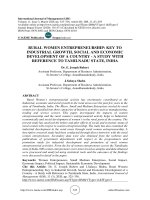Economic growth and economic development 689
Bạn đang xem bản rút gọn của tài liệu. Xem và tải ngay bản đầy đủ của tài liệu tại đây (83.86 KB, 1 trang )
Introduction to Modern Economic Growth
relative demand curve must be downward-sloping. In contrast, ET2 , which applies
when the conditions of Proposition 15.4 hold, is upward-sloping. Higher levels of
relative supply of skills correspond to higher skill premia.
A complementary intuition for this result can be obtained by going back to the
importance of non-rivalry of ideas as discussed in Chapter 12. Here, as in the basic
endogenous technology models of the last two chapters, the non-rivalry of ideas
leads to an aggregate production function that exhibits increasing returns to scale
(in all factors including technologies). It is the presence of this increasing returns
to scale in the technology of the economy that leads to potentially upward-sloping
relative demand curves. Put differently, the market size effect, which results from
the non-rivalry of ideas and is at the root of aggregate increasing returns, can create
sufficiently strong induced technological change to increase the relative marginal
product and the relative price of the factor that has become more abundant.
15.3.3. Implications. The results of Propositions 15.3 and 15.4 are not only of
theoretical interest, but also shed light on a range of important empirical patterns.
As already discussed above, one of the most interesting applications is to changes in
the skill premium. For this application, suppose that H stands for college-educated
workers. In the U.S. labor market, the skill premium has shown no tendency to
decline despite a very large increase in the supply of college educated workers. On
the contrary, following a brief period of decline during the 1970s in the face of
the very large increase in the supply of college-educated workers, the skill (college)
premium has increased very sharply throughout the 1980s and the 1990s, to reach
a level not experienced in the postwar era. Figure 15.1 above showed these general
patterns.
In the labor economics and parts of the macroeconomics literature, the most
popular explanation for these patterns is skill-biased technological change. For example, computers or new IT technologies are argued to favor skilled workers relative
to unskilled workers. But why should the economy adopt and develop more skillbiased technologies throughout the past 30 years, or more generally throughout the
entire 20th century? This question becomes more relevant once we remember that
during the 19th century many of the technologies that were fueling economic growth,
675









